The House That Flipper Built
Written by Gaspar González - Biscayne Times Contributor
March 2012
North Miami’s contribution to American pop culture, from TV’s most famous dolphin to Miami Vice and beyond
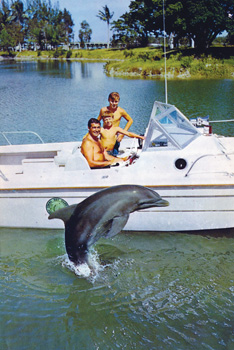 |
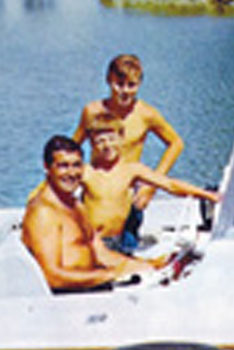 |
| Flipper photos courtesy of Frederick Barr | |
From the outside, Greenwich Studios doesn’t look like much: a cluster of warehouse-size buildings fronting NE 16th Avenue, between 121st and 122nd streets. The studio’s name, spelled out in blue letters and punctuated by a leaping dolphin, is visible only from the north side of the property, and then only if you’re really looking for it.
Turn your head for a moment -- or approach the buildings from the south -- and you could easily confuse Greenwich for a storage rental facility. There are quite a few such businesses in this industrial strip running just west of, and parallel to, Biscayne Boulevard in North Miami.
But Greenwich is special. It was once an epicenter of American television production, turning out hit shows that baby boomers still recall with glee, among them, Flipper, the series about a pet dolphin that helped make South Florida famous and launched a million school lunchboxes.
Back then, the complex wasn’t called Greenwich, but Ivan Tors Studios. A Hungarian with a colorful past, Tors was, for a time, one of Hollywood’s most successful producers, rivaling even Walt Disney when it came to reeling in the kiddies with fantastic and farfetched science-fiction and adventure stories. Now the studio he built mostly churns out Spanish-language reality shows. It also produces the occasional ghost tale.
"The place is haunted, you know," says Jeff Beal, a writer-for-hire and sometime producer who keeps an office at Greenwich. He is on the phone with a reporter curious about the studio.
"By whom?" the reporter asks.
"Ivan Tors."
Who else?
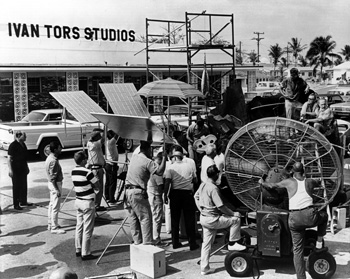 |
| Shooting a scene from Around the World Under the Sea in 1965, with actors Marshall Thompson, David McCallum, and Keenan Wynn at upper right. Photo courtesy of HistoryMiami. |
Tors, it seems, was always a bit of a mysterious character. "He
was in the OSS [Office of Strategic Services] and he very possibly
was a spy," says David Tors, speaking from his home in Kentucky
about his father’s World War II experiences, "although
I can’t get anybody to admit it." He laughs. "Anyway,
he got hurt somehow and was reassigned to the squadron that featured
Glenn Miller."
That would have been the Army Air Force Technical Training Command (AAFTTC) band, stationed in New Haven, Connecticut, in 1943. Miller, at the time arguably the nation’s most popular big-band leader and a newly minted captain in the Army Air Corps, was given the task of keeping American morale high with his signature swing sound.
What Tors might have been doing with the outfit is unclear; regardless, the assignment would pay off after the war. "That’s where he got some of his contacts in show business," explains David.
Those contacts led Tors to Hollywood, where he found work as a writer. His first effort -- he got credit for the original story -- was a gangster picture of sorts, involving a returning vet who takes over his dead brother’s illegal gambling operation. It was a solid "B film," low on budget, stars, and running time, but it must have gotten the 30-year-old Tors noticed, because his next three credits would have made any writer of the era envious.
First came Song of Love in 1947. A lush, historical romance woven around the life of 19th-century German composer Robert Schumann, it starred Katharine Hepburn and Paul Henreid, the suave leading man who had played Ingrid Bergman’s husband in Casablanca. That was followed by That Forsyte Woman, an historical melodrama starring screen swashbuckler Errol Flynn, and In the Good Old Summertime, a turn-of-the-20th-century "boy and girl love each other, but don’t know it yet" musical, with a still innocent-seeming Judy Garland hitting all the right notes. The New York Times called it "a wonderfully rich entertainment."
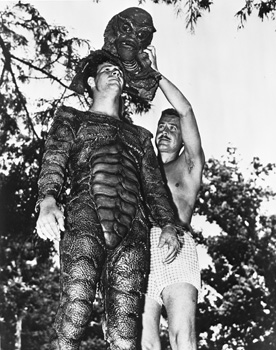 |
| Actor Ricou Browning being fitted in his costume for Creature from the Black Lagoon, 1953. Florida State Archives Photographic Collection. |
In a very short time, Tors had proven he could pen a star vehicle and had demonstrated an affinity for nostalgic storylines and family fare, which would serve him well in years to come. He wasn’t yet a producer, but that would come, too, with a flurry of science-fiction adventure films in the early 1950s, titles like The Magnetic Monster, Riders to the Stars, and Gog, about a series of unexplained murders at a top-secret government laboratory. It was fantasy stuff aimed at the teenagers who were increasingly filling the country’s movie theaters; Tors was mining the "youth market" before that term had become part of the lexicon.
Perhaps it was only natural he would gravitate toward television, that new electronic extension of the American family. His first foray into the TV age was Science Fiction Theatre. A forerunner to Rod Serling’s more famous Twilight Zone, the conceit of Science Fiction Theatre was that its stories were at least partly based on scientific discoveries. "I’ll tell you now that this story is fiction," host Truman Bradley would regularly intone at the top of an episode. "It did not happen. But the big question is, ‘Could it have happened?’" Science Fiction Theatre ran for two seasons.
In 1957 Tors had an idea for a different kind of adventure show, one that would take place underwater. Its lead character would be an ex-Navy scuba diver named Mike Nelson, played by Lloyd Bridges (father of actors Beau and Jeff Bridges).
In each half-hour episode, Nelson would use his scuba skills to help clients retrieve valuable property from the ocean floor, rescue people in distress, outsmart the bad guys, and anything else that needed to be done that required a wet suit and a set of swim fins. At the end of each episode, Nelson would address the audience directly, asking viewers to help protect the world’s oceans. Tors would call his show Sea Hunt.
The three major networks -- ABC, CBS, and NBC -- turned down the idea.
Who wants to see a show about a frogman?
There’s no dialogue when he’s underwater.
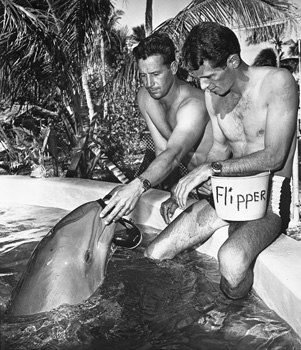 |
| Ricou Browning and trainer Ric O’Barry with one of the Flipper dolphins (undated photo). Florida State Archives Photographic Collection |
But Tors was undeterred. He produced a pilot and sold the show into first-run syndication. Sea Hunt became a smash, running for 155 episodes between 1958 and 1961. The show also brought Tors to Florida, where he met Ricou Browning.
"I was working as the assistant director of public relations at Silver Springs in Ocala," recalls Browning, now 82 years old. Tors, according to Browning, was scouting locations for the second season of Sea Hunt, when "Ivan saw me swimming and said, ‘Hey, how’d you like to swim for me?’"
If this sounds a little like the classic story of some lucky kid being plucked from obscurity by the big Hollywood producer, it isn’t. Browning, a Florida native, was an accomplished swimmer and diver who’d been doing underwater tricks for the newsreels since the early 1940s, and whose cinematic fame had been assured a few years earlier: Wearing a green rubber suit, he had played the eponymous lead in the 1954 monster cult classic Creature from the Black Lagoon.
On Sea Hunt, Tors had Browning double for the bad guys in the underwater scenes. In time the two men became friends and business partners. They formed Underwater Studios, a production company based in Nassau, specializing in underwater cinematography. "We shot our own shows there, as well as underwater sequences for other shows and movies," explains Browning. Among these was the 1965 James Bond thriller Thunderball, which claimed an Academy Award for Best Visual Effects for its extensive deepwater action footage.
The inspiration for Browning’s biggest contribution to the partnership was born one afternoon when he observed his children planted in front of the television. "They were watching Lassie," says Browning, "and I thought, ‘Why not do something with a boy and a dolphin?’ I remembered all this Greek mythology about boys on dolphins, and I’d seen trained dolphins [at water shows]."
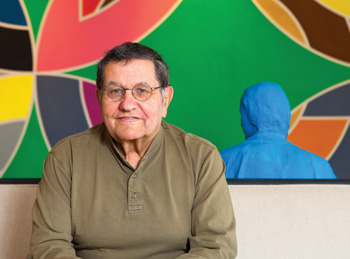 |
| Developer Martin Margulies: "I had no idea what to do with the studio, so I lent it to a group of artists, rent-free." BT photo by Silvia Ros. |
The underwater stuntman’s first thought had nothing to do with television. "My brother-in-law, Jack Cowden, and I spent a weekend writing a summary of a book," he says. "I took the idea to publishers in New York, and never heard back from any of them."
It was only then that Browning turned to Tors for help, but again, not because he was thinking of this as a TV or movie property. That was just a ruse. "I thought if I could get a movie producer to say he was interested in producing my story, the publishing houses would get off their rear ends," Browning recounts, laughing because he knows how the story ends.
Tors told him he would go along with the idea, and to send him the book proposal, just for the hell of it. When he got it, Tors recognized the story really was just Lassie on the water, but that’s what made it attractive: A young boy named Sandy Ricks, the son of a Florida Keys fisherman, befriends a bottlenose dolphin. His father doesn’t much like the idea, until the dolphin rescues Sandy from a shark attack. The story ends with the family agreeing to keep the dolphin, which Sandy has named Flipper. Forget the book, Tors told Browning. Let’s make a movie.
The idea would have appealed to Tors for several reasons, the most obvious being that it would be shot on and around the water, which was his specialty. Another reason was that it would be wholesome -- critics might call it hokum -- family entertainment, something Tors believed was in short supply.
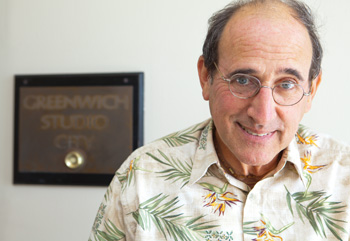 |
| Jeff Beal is the studio’s knowledgeable go-to guy: "The place is haunted, you know." BT photo by Silvia Ros |
He’d been outspoken on the point. In 1961 the producer testified
in front of the U.S. Senate’s Juvenile Delinquency Committee,
complaining of pressure from the networks to put more sex and violence
into the shows he pitched them. Tors thought TV should aspire to
more. "We have no excuse to make any kind of shows only because
they are profitable," he told the senators. "I think we
have a tremendous responsibility, which I see more and more as my
children grow up and I see how they are affected adversely by TV
viewing." On occasion, he would also tell reporters that he
was frustrated because "I have three sons, and if a Disney picture
isn’t showing, we can’t go to the theater together."
(Tors’s sons -- Steven, Peter, and David -- were born to the actress Constance Dowling, whom Tors wed in 1953. The couple was introduced, says David, by Hollywood legend Shelley Winters.)
If Tors admired the Disney formula -- and who didn’t -- might not Flipper, as the dolphin film would be called, be able to capture some of that same magic? Tors knew that casting would be critical. For the part of Porter Ricks, the fisherman dad, he sought out Chuck Connors, who was the star of the hit TV western The Rifleman. For the role of Sandy, he needed a kid who looked comfortable outdoors, and settled on a 14-year-old actor named Luke Halpin.
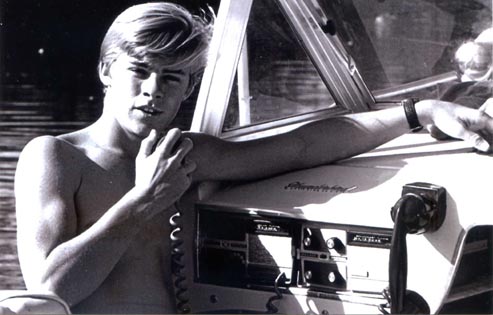 |
| Luke Halpin |
Halpin, now 64 years old and living on Florida’s west coast, remembers his first meeting with Tors: "I’d been doing a Broadway play with Jackie Gleason, and someone came up to me after the show and said, ‘Ivan Tors would like to speak with you.’ I knew who Ivan Tors was because I used to stay up to watch Sea Hunt."
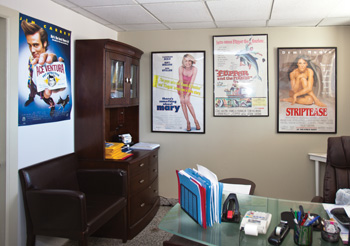 |
| There has been a steady flow of Hollywood productions over the past two decades, including Something About Mary. BT photo by Silvia Ros. |
Good thing, because otherwise one of Tors’s first questions
to Halpin might have sounded rather odd. "Would you be afraid
to swim with live dolphins or live sharks?" Tors asked the youngster.
Halpin jumped at the offer -- "I loved the idea of playing Sandy" -- and filming began, despite skepticism in some quarters. "A lot of people thought you couldn’t do a movie like Flipper," says Halpin, "because you couldn’t get a dolphin to do the tricks. But Ivan was a very rare person. He had great insight."
He also had the good fortune of finding just the right dolphin. "For Flipper", says Browning, "we tried to get an animal that was already trained, but all the ones we saw were only trained to do tricks [above water]." That’s when he and Tors heard of Milton Santini, who ran a "porpoise school" in the Florida Keys. Santini, Browning recalls, kept a pet dolphin named Mitzi. When Browning waded into Mitzi’s pond, the female dolphin swam right up to him, and Tors knew he had his leading man, er, lady.
(Credit for training Mitzi to play Flipper has been shared by everybody from Santini to Browning to Dale Hyldahl, who worked with dolphins at Marineland, the oceanarium near St. Augustine. Flipper’s most famous trainer, Ric O’Barry, now a vocal critic of dolphin captivity, didn’t join the Flipper franchise until later.)
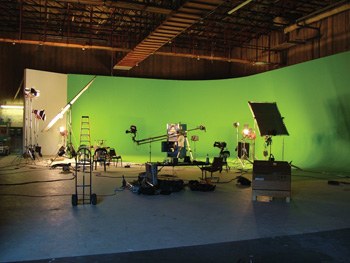 |
| A green-screen set at Greenwich Studios today, where Spanish-language reality shows dominate. Photo courtesy of Jeff Beal. |
Flipper made a late-summer splash at the box office in 1963. Produced
for a reported $500,000, newspapers projected the film to gross between
$5 million and $8 million by year’s end. Flipper was suddenly
the most famous marine mammal on the planet, and Tors wasted no time
cashing in. He made a deal for a sequel, as well as a new half-hour
prime-time television show. "We started shooting the second
feature film [Flipper’s New Adventure] and the first episode
of the TV series at the same time," says Browning.
The series required some tweaks. The father now would be played by Brian Kelly, and his new occupation would be game warden, while Sandy would get a little brother named Bud (Tommy Norden).
But that was minor compared to the logistical challenges of building a show around a dolphin. A series translated to approximately 30 episodes per season. Flipper would need a permanent home, and South Florida was deemed the ideal place. It was close to the Bahamas, where, owing to the underwater topography, ocean scenes could be filmed, and the Miami Seaquarium was home to the stars of the show -- Flipper would be played by five female dolphins.
(The Seaquarium would also double as a set. The Ricks’s Cracker-style cottage was built there, to go with an exact replica erected at the old Interama site, now Florida International University’s Biscayne Bay campus. The identical sets, says Halpin, gave producers flexibility when it came to filming exteriors.)
The only thing Tors didn’t have was a studio, but he found one. Or at least, the beginnings of one. Thunderbird Studio in North Miami, according to Browning, was operated by a soundman named Howard Warren. "It was only one stage," says Browning. But there was room to grow.
Renamed Ivan Tors Studios, the facility officially opened in the spring of 1964. Over the next couple of years, Tors would build three more sound stages, the two largest of which possessed 40-foot ceilings and could be configured into a single 16,000-square-foot space.
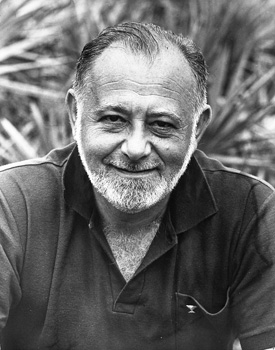 |
| Though his fortunes eventually faded, Ivan Tors created a unique brand from his studios in North Miami. Florida State Archives Photographic Collection. |
In addition, there were offices, a carpentry shop for building sets, and a back lot, not to mention employees -- 150 of them, with an estimated annual payroll of $3 million. By 1966 it was believed to be the largest production facility in Florida, and one of the largest anywhere outside California and New York.
"We were the only studio down here," says Browning, who eventually became studio president. "We were doing TV shows. We did two different Jackie Gleason films. And we had the [underwater filming business] locked up."
The South Florida location resulted in a more relaxed work environment, according to Halpin: "There was a freedom of not working in Los Angeles. The entire [Flipper] crew was as much of a family as anything. If the weather was going to turn bad, Ivan would tell everybody to go home. He was very protective."
Why not? Flipper was the flagship, the dolphin that laid the golden egg. Running for three seasons on NBC, from 1964 to 1967, the show probably did more to popularize Ivan Tors Studios -- and South Florida -- than a boatload of press agents working overtime could ever have managed. "Imagine if you lived in Pennsylvania in 1965," says Scott Cardinal, director of the recent documentary The Legend of Ivan Tors. "It’s winter, and you turn on the TV and you see two kids swimming with a dolphin. You think you might come down to Florida? Ivan was responsible for bringing millions in tourist dollars to South Florida."
Halpin still marvels at the novelty of it all. "Ivan was very clever," says the former actor. "Two kids with their own boat, their own gear, a pet dolphin, and a father who’s a game warden and not around very much. It was a great set-up for a show."
Tors followed up the success of Flipper with more animal-themed productions, including Zebra in My Kitchen, a 1965 film starring former Dennis the Menace child star Jay North as a proto-animal-rights activist who springs his furry friends from the local zoo, and two TV series: Daktari, about a veterinarian who studies animal behavior in Africa, and Gentle Ben, the adventures of a young boy (played by Ron Howard’s little brother, Clint) and his pet bear. Not all were Florida-based -- Daktari was shot in California -- but Gentle Ben, set in the Everglades, was produced out of the North Miami studio and utilized Fairchild Tropical Botanic Garden as a shooting location.
By the late 1960s, newspaper and magazine articles were asking if Tors was "the new Disney," to which the Hungarian usually replied, "I don’t want to be the second Walt Disney. I want to be the first Ivan Tors."
Not every new undertaking was a success. A daytime game show Tors unveiled in 1967, Treasure Isle, was a flop, and an expensive one. A venture with Florida billionaire John D. MacArthur, Treasure Isle was billed as the world’s first outdoor game show.
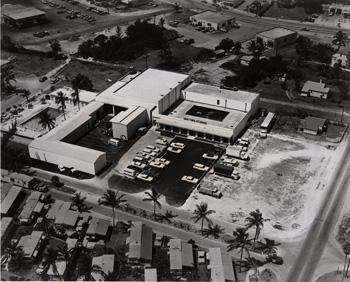 |
| Aerial view of studios |
The concept called for competing couples to paddle around a lake in a canoe, looking for clues that would lead them to the "treasure isle," where they would dig for prizes. Sherman Adler, who was involved with the show, years later characterized it as "part Newlywed Game and part Survivor." Shot on location in Palm Beach County, the show’s manmade set consisted of a lagoon and three "islands," at a cost of half a million dollars. It lasted one season.
In retrospect, it was a sign of things to come. Tors’s amazing run, dating back to Science Fiction Theatre and Sea Hunt, was nearing its end. Some of it was probably just show-biz physics: Everything that goes up sooner or later must come down.
In Tors’s case, his core audience of baby boomers was growing up, and now more concerned with Vietnam, the Civil Rights struggle, and the counterculture than what their favorite animals were up to in prime time.
Flipper went into reruns in 1967; Daktari and Gentle Ben were canceled outright in 1969. To make matters worse, that same year Tors’s wife, Constance, died of a heart attack. With Tors’s personal life upended and his homegrown lineup of shows history, says Browning, "we started leasing space to other [production companies]."
According to pioneering Miami independent filmmaker Bill Grefé,
who succeeded Browning as studio president in 1970, Tors had also
been relying on loans to keep his filmmaking ventures afloat. "He
borrowed a lot of money from Bruce Norris, whose family owned the
Detroit Red Wings hockey team," recalls Grefé.
Newspaper clips from the era support Grefé’s recollections. The Miami News reported in late 1967 that Norris "had purchased a substantial stock interest in the Tors corporation," and by early 1968 was claiming that Norris "[had] become a partner handling the financial end of the Tors property." Norris, says Grefé, eventually came to hold the mortgage on the property, after which the studio "became secondary" to Norris’s other business concerns.
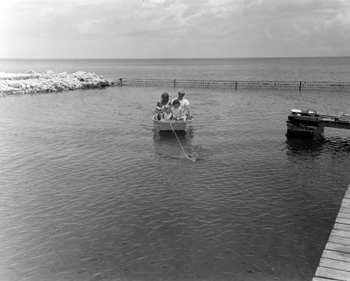 |
| Family being towed in boat pulled by Flipper (Mitzi) - Marathon, Florida |
Despite his setbacks, Tors would attempt to produce one last series in the studio he’d built. Primus, David Tors remembers, was a "mini-adventure underwater show." It premiered in 1971 and sunk so quickly not even super-diver Mike Nelson could have found it.
After that, Tors left North Miami, though not the entertainment business. "Ivan took my brothers and me to Germany and Africa with him," says David. "He did some animal shows for German television and a film, Escape from Angola, that we were all in."
Tors never found even a sliver of the success he had once enjoyed -- David says his father spent the 1970s "pitching ideas to young punk executives," with predictable results -- although he did manage to pass on his love of wildlife to his children; son Steven is a safari guide in Africa.
Tors died in 1983 of an apparent heart attack. It happened in Brazil, while the producer, keeping in character, was on a scouting trip for a TV series he was trying to get off the ground. Tors was only 67. The timing was cruel. If he had lived just a little while longer, he might have gotten a real kick out of what was going on at his old studio.
"Do you remember what South Beach was like before Miami Vice?" asks Jeff Beal, leaning back in his office chair. "Boarded-up storefronts, abandoned buildings." Beal pauses in midsentence, before making the sign of the cross. "Thank you, Miami Vice."
Beal, the self-described "de facto go-to guy" whenever a new production sets up shop at the studio, is retailing the oft-told tale of how Miami Vice swooped into town in 1984 to save South Florida from cultural irrelevance. That’s always been a bit of an exaggeration, but the series undeniably helped save Ivan Tors Studios. "They built their sets here," says Beal. "The police station, mostly."
"I got lucky," says developer and renowned art collector Martin Margulies, recounting how, for five seasons, Miami Vice became the best tenant any studio could have envisioned.
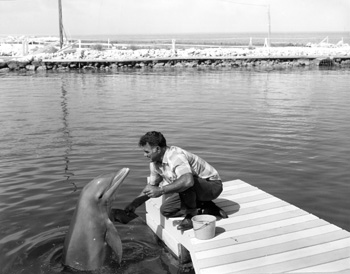 |
| Milton Santini shakes dolphin flipper during training at Santini's Porpoise School. |
Margulies bought the property from Bruce Norris’s company in 1980. He wasn’t looking to get into the movie business; he wanted to develop the surrounding land, but it was a package deal. "I bought all that land and developed Greenwich [Park] condominiums," he says, speaking of the complex just to the west of the studio. "But I had no idea what to do with the studio, so I lent it to a group of sculptors and artists, rent-free, because I’m an art collector. Guys were sleeping there." Miami Vice changed all that, of course.
Under Margulies, the property -- studio and condos -- came to be called Greenwich Studio City. (The name is reminiscent of Los Angeles’s Studio City, a neighborhood developed around silent-film producer Mack Sennett’s movie-making factory in the 1920s.)
Margulies was happy to take Miami Vice’s money as long as the series ran, but he wasn’t an entertainment mogul, and he knew it. "[The studio] was a project that I just had no more heart for," he says. "I wanted out -- and Stanley Markofsky gave me that out."
Reached by phone at his office in Fort Lauderdale, Markofsky, president of Skymark Real Estate Investments, laughs when asked if Miami Vice convinced him to buy Greenwich from Margulies in the late 1980s: "Miami Vice’s contract expired two months before I closed on the property."
Like Margulies before him, Markofsky was primarily interested in the land. He built rental apartments to go with the condos, and "wanted to tear down the studio and build more rental apartments, but the city objected, so I said, ‘Okay, I’ll run it as a studio.’"
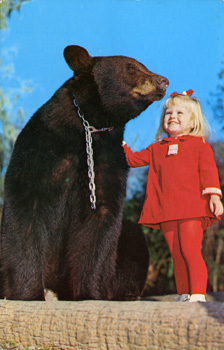 |
| "Gentle Ben" at Homosassa Springs |
That’s a tidier version of events as reported in newspapers at the time. In March 1989, Markofsky told the Miami Herald he planned to turn one of the studio’s massive, hangar-shaped buildings into a storage facility, and perhaps introduce a retail element. At a time when the City of North Miami’s official motto was "Florida’s Film and Recording Capital" -- a nod to both Tors’s legacy and the presence in the city of Criteria Recording Studios, now the Hit Factory -- those were fighting words. "The talk was that they wanted to do a shopping mall," says David Tors. "That pissed off a lot of people."
In the end, Markofsky and the city did reach a compromise. The city ceded control of the portion of NE 121st Street that runs in front of the studio in exchange for Markofsky’s pledge to keep Greenwich operational.
"As a residential developer, I never thought I’d get involved in something like a studio," says Markofsky, echoing the sentiments of the previous owner. Markofsky, like Margulies before him, nevertheless gave it a try. He undertook an extensive renovation of the buildings, popularized the Greenwich name -- "We had a big sign on U.S. 1 that said Greenwich Apartments and Studio" -- and even managed to land a full-time tenant, the Spanish-language soap opera El Magnate (The Magnate).
But like Norris and Margulies, Markofsky eventually threw in the towel. "I was there for a few years, we built 400 apartments, and sold the whole package," he says, summing up his short-lived career as a studio boss.
Enter current owner Sylvan Adams. Described by Canada’s Financial Post as "one of the shrewdest and richest real estate developers" in that country, Adams purchased the Greenwich property in 1990 for $7.2 million. Based in Montreal and largely an absentee landlord -- "He used to show up about once every three years," says Beal, though he notes visits have become more frequent -- Adams has nevertheless preserved Greenwich as a working studio.
Posters and photographs in the waiting area of the administrative office attest to the steady flow of Hollywood productions over the past two decades: Ace Ventura: Pet Detective, True Lies,Striptease, Something About Mary, Bad Boys II, and Stuck on You. ("You know," says Beal, "that’s the one where Matt Damon plays a twin joined at the hip with his brother.") There are also glossies of Gloria Estefan, Enrique Iglesias, and other music acts that have either filmed videos at Greenwich or used the studio as rehearsal space to prepare for tour dates.
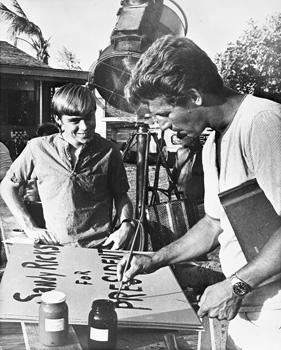 |
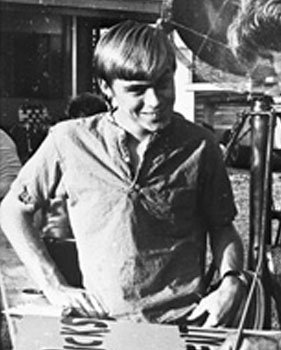 |
| Luke Halpin and Ricou Browning | |
According to Beal, in recent years the studio’s best clients have been Hispanic productions: "The Spanish-language version of Dancing with the Stars [Univision’s Mira Quién Baila] and reality shows having to do with beauty contests. The past five years, this place has been booked every day, 365 days a year." To make his point, he tells the story of the time, four years ago, he had to turn down a request for studio space from Paul McCartney.
Perhaps. But on this day, the only visitors to the studio are a work crew doing some upkeep of the administrative building’s courtyard, and a couple of cleaning ladies. It’s a reminder that, when it comes to maintaining a facility like this, you can never have enough business.
"Sylvan Adams won’t make a deal," says Beal, by way of explaining the lack of activity on this day. "He won’t provide somebody with space for [consideration] on the back end." Beal pauses, searching for the quickest shorthand he knows: "He’s not a movie guy."
Indeed, there hasn’t been "a movie guy" since Tors, and the studio is unlikely to have a future to compete with its past. "People come to Florida for the location, not because there’s a studio here," says Ricou Browning, speaking from experience. "So if all you have is a studio, it’s hard to make a living."
It’s also true that Greenwich is no longer the obvious choice for studio space in South Florida. Other venues attracting production companies include Ice Palace Film Studios near downtown Miami and the Coconut Grove Convention Center, where the cable series Burn Notice has been shooting since 2007.
(The latter is a sore spot for Greenwich. Burn Notice shot its pilot at Greenwich in 2006, before the City of Miami moved in and offered the show’s producers a sweetheart deal if they would relocate to the Grove. "Did the city hurt [my] business?" Greenwich general manager Carlene Tiedemann told the Herald in 2008. "The answer is yes.")
And if developer Michael Swerdlow is to be believed, competition is only going to grow. In development plans for Biscayne Landing, Swerdlow has floated the possibility of erecting a 200,000-square-foot TV and film production studio.
If any of this fazes the staff at Greenwich, they’re not letting on. "Everybody talks about building production facilities down here; that’s all Sylvester Stallone talked about in the late 1990s," says Beal.
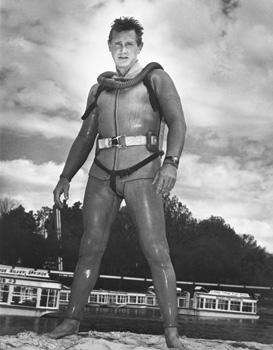 |
| Lloyd Bridges in "Sea Hunt" |
His point? That for all the hype about South Florida as a movie mecca -- the dream of a new, subtropical Hollywood springing up here has been a recurring theme since at least the 1960s -- it remains the case that Tors did it first and, arguably, got closer to the ideal than anybody who’s likely to follow in his footsteps.
Tors didn’t just provide a black-box backdrop for other people’s productions. He created a unique brand, put his personal stamp on hundreds of hours of television shows and movies, and made South Florida, for longer than a hot minute, a leading site of film and TV production. And he did it all from a studio he built from the ground up in North Miami.
Which is why it’s all the more remarkable that the only visible traces of Tors’s reign as the king of 1960s kid-friendly TV (Uncle Walt notwithstanding) are a few blocks of NE 16th Avenue, renamed "Ivan Tors Boulevard" in 1983, and a small bronze plaque just outside the Greenwich gates on NE 121st Street.
The plaque, which contains a relief of Tors surrounded by his beloved animals and declares the studio "an important landmark in the City of North Miami," appears to receive very little attention from either the studio or the city. Discolored and dotted with dried pigeon droppings, it isn’t much of a tribute.
Then again, maybe Tors isn’t really gone. There are those ghost sightings Beal mentions. "I haven’t seen anything myself," the studio’s go-to guy confesses when pressed, "but people here late at night have seen things. They all describe Ivan Tors when he had a beard." (In his later years, Tors resembled a kind of Hungarian Hemingway.)
One time, the studio’s artist-in-residence felt his blanket being pulled off him as he slept in the loft over the carpentry shop; the man is said to have awakened to the sight of Tors, wearing an overcoat, standing at the foot of the bed. Another time, an air-conditioning technician claimed he encountered the spectral presence in the makeup room at the north end of Studio B.
Beal assures potential clients the ghost is harmless: "He hasn’t
done anything mischievous. Mostly he stays in the shadows. Perhaps
he’s just pleased to see that production is still going on
in the house he built."
-------------------------------------
(Additional images by cpps90)